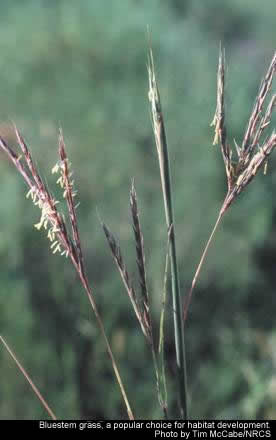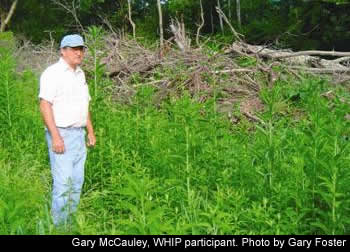

WHIP Your Land Into Shape By Gary Foster West Virginia is truly blessed with an abundance of wildlife resources and the associated recreational opportunities which those resources provide to our state's citizens. According to a recent landowner survey conducted by the Division of Natural Resources, many landowners own property in the Mountain State so that they may enjoy the wildlife resources on their property. In fact, 76 percent of landowners felt that hunting, fishing and other forms of wildlife-oriented recreation were important values associated with their property. With private lands constituting almost 90 percent of the land base in West Virginia, private landowners share a duty to be responsible stewards of our state's wildlife and its other natural resources. In today's society, more than at any time in our nation's history, property owners are becoming more conservation minded and interested in managing the wildlife habitat on their property. Unfortunately, as so often is the case, funding is often the difference between good intentions and the implementation of a sound wildlife management plan. So, if you are interested in managing your lands for wildlife and need financial assistance to help cover the costs of implementing habitat enhancement practices, then you may want to “WHIP” it. That's a reference to the federal Wildlife Habitat Incentives Program (WHIP), a voluntary program for landowners who wish to develop and improve wildlife habitat on their property. WHIP is one of several federal “Farm Bill” programs administered by the U.S. Department of Agriculture's Natural Resources Conservation Service (NRCS). West Virginia's WHIP objectives focus on the following four habitat types: farm wildlife habitat, riparian wildlife habitat, threatened/endangered species, and woodland wildlife habitat. The primary purpose of the program is to address wildlife habitat needs such as the development and maintenance of grassland and early successional forested habitat. Applications that provide the greatest wildlife habitat benefits based upon the state's ranking process will receive the highest priority.
The Wildlife Habitat Incentives Program offers landowners a wide array of conservation practices based upon the landowner's objectives and the plan developer's recommendations. Landowners are often interested in developing a general wildlife management plan which would benefit a wide variety of wildlife species. In other cases, the focus of the plan may be on developing habitat for a specific species such as ruffed grouse or possibly for grassland and ground-nesting songbirds. Conservation practices available through WHIP include, but are not limited to: tree/shrub plantings, development of herbaceous openings, field border cuts, forest openings, native grass plantings, and fencing to exclude livestock from woodlots or streams. The development of herbaceous openings or permanent food plots are commonly implemented practices which provide valuable forage and cover for a variety of wildlife species. Forest openings resulting from clearcuts or shelterwood timber harvest approaches provide quality habitat for years to come for species such as ruffed grouse and woodcock which thrive on early successional forested habitat. Native grassland plantings which incorporate grass species such as switchgrass, indiangrass and bluestem are commonly planted to provide nesting habitat and cover for a variety of ground-nesting songbirds, rabbits and other wildlife species. WHIP also provides cost-share incentives toward the maintenance of grassland and/or fallow habitat through practices such as strip-disking, brush-hogging fields and forage management. The program does not provide cost share assistance for the establishment of annual food plots, such as corn or wheat fields, but emphasizes the establishment of perennial types of wildlife cover and forage such as legumes and grasses. In addition to providing valuable wildlife habitat, many of the conservation practices also address environmental concerns such as nutrient runoff and soil erosion. Conservation practices such as critical area plantings, exclusion (stream bank fencing, for example), and forested and herbaceous buffer strips all provide valuable wildlife habitat while addressing environmental issues. Gary McCauley, a landowner in Barbour County , enrolled in the program last year and has had a very positive experience. “WHIP is a win-win situation for landowners and for improving habitat for wildlife,” he says. “The people involved at the DNR and NRCS have been very helpful and good to work with.” WHIP participants are required to enter into a 5- to 10-year cost-share agreement with the NRCS, which provides between 50 to 100 percent of the cost of installing and maintaining the various conservation practices. Trained staff of the NRCS or the DNR complete the detailed wildlife habitat develop ment plan. Numerous other conservation programs are available to farmers and landowners throughout the state to address soil, water and wildlife issues on their property. These programs, listed with the agency that administers them include: the Forestland Enhancement Program & Forest Stewardship Program (WV Division of Forestry), Conservation Reserve Program & Conservation Reserve Enhancement Program (Farm Service Agency), Environmental Quality Incentives Program (NRCS), and the Partners for Fish & Wildlife Program (U.S. Fish & Wildlife Service). Be advised that program funding levels may vary from year to year because congressional budgetary appropriations often fluctuate annually. West Virginia landowners have a duty to be responsible stewards of the land and our state's natural resources. As our country's human population continues to grow and expand, additional demands will be placed upon our wildlife resources and their associated habitats. If you are a landowner with an interest in managing your lands for wildlife, then you may want to consider the Wildlife Habitat Incentives Program. Landowners interested in WHIP or who have questions, should contact their local USDA Service Center, their Division of Natural Resources district office or go online at www.wv.nrcs.usda.gov/programs/whip.html for additional details. Gary Foster is the district wildlife biologist stationed in Farmington. |

